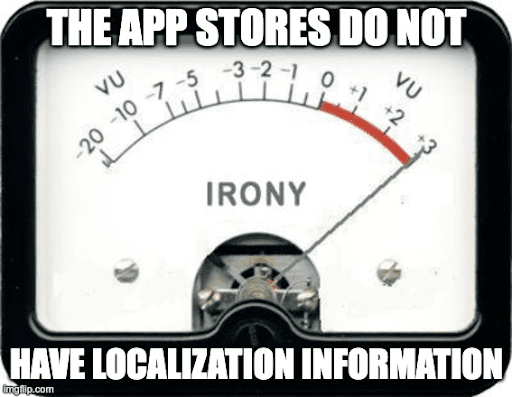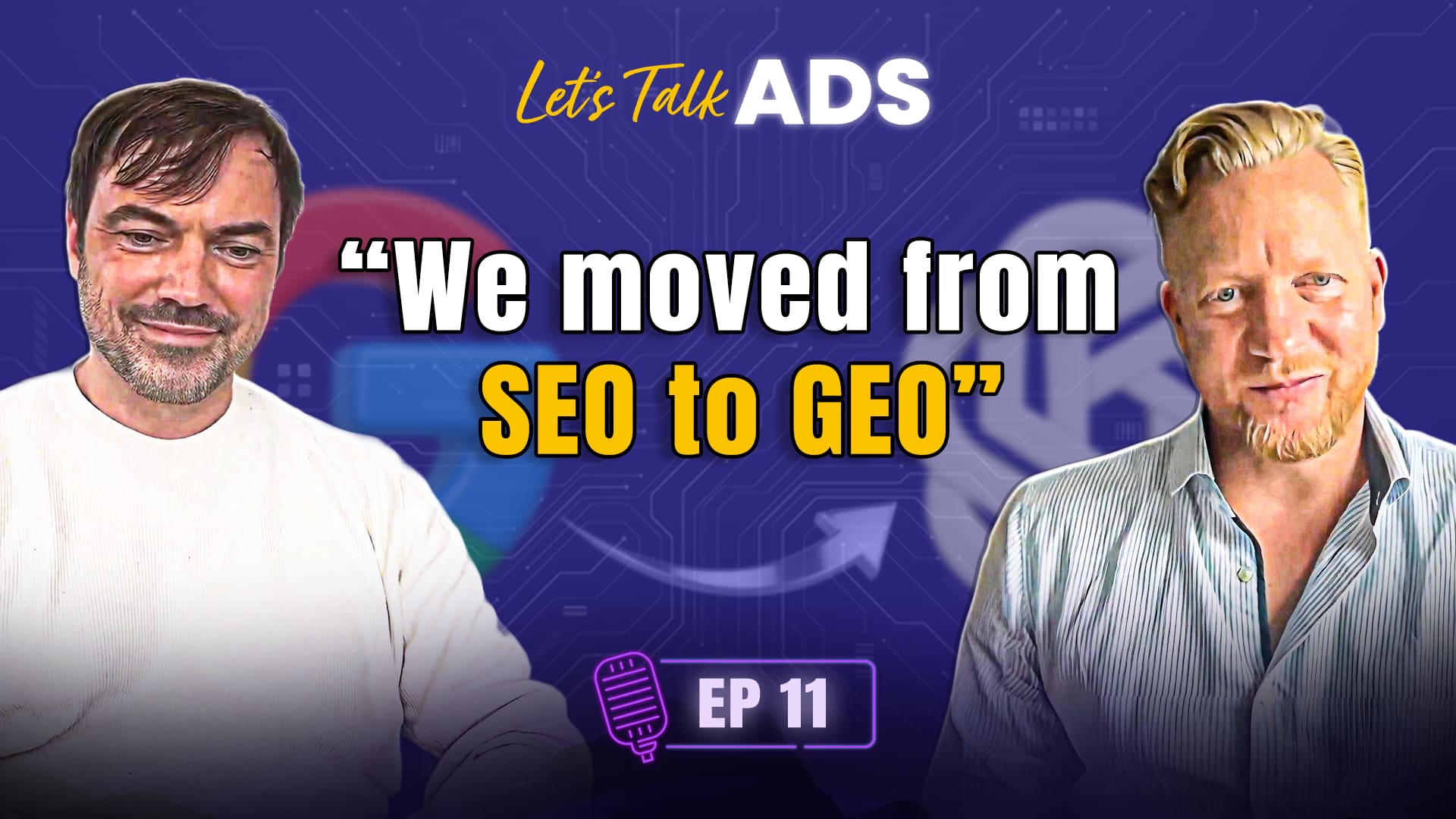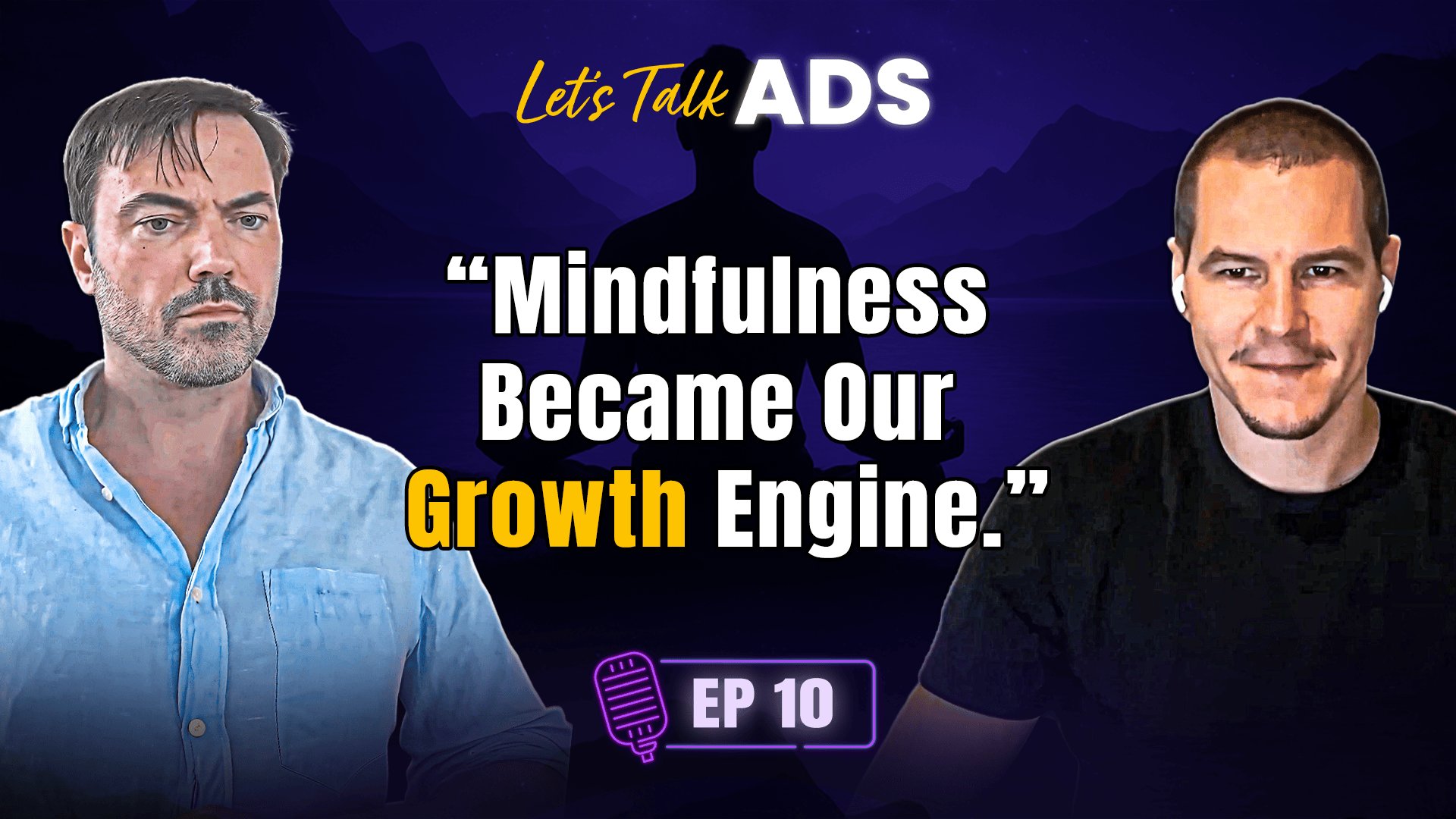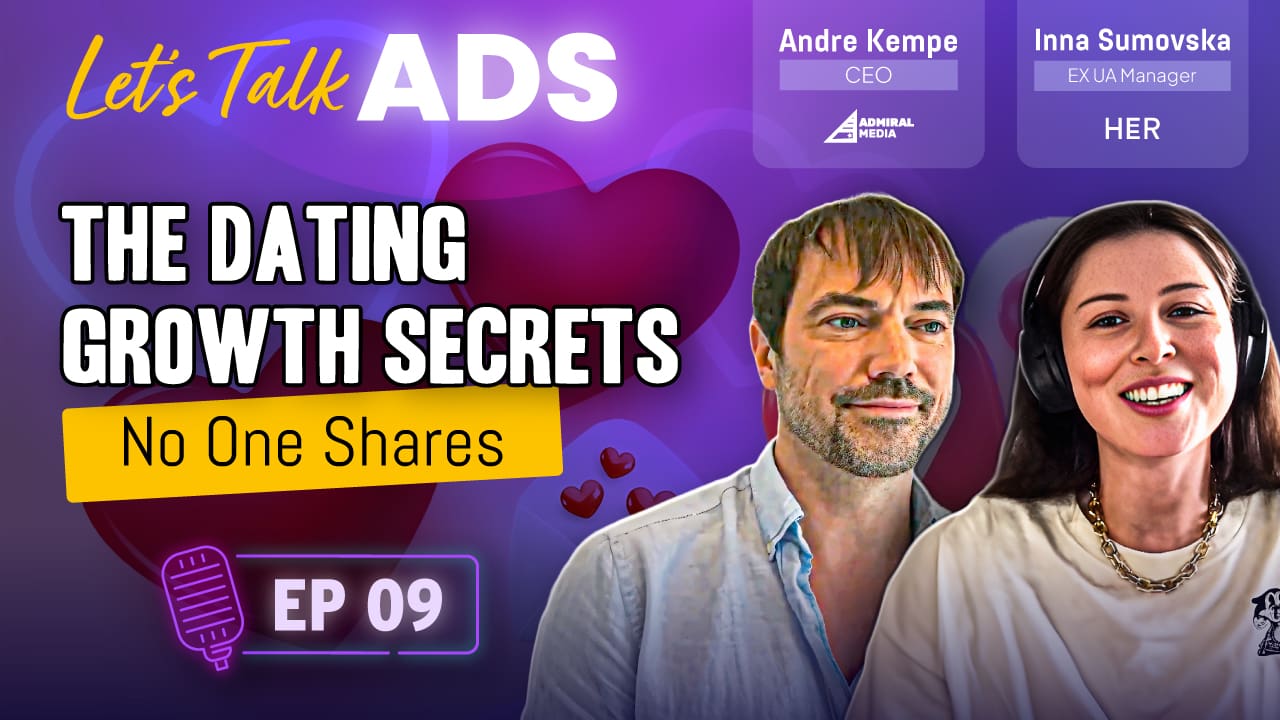Marlin and Dory while searching for Nemo. SpongeBob and Patrick causing mischief underwater. Shrek and Donkey conquering princesses and dragons. Frodo and Sam destroy the ring. Sherlock and Watson investigating complicated murders. Mario and Luigi face off against villains and save (multiple) worlds. Batman and Robin saving Gotham. Or even Woody and Buzz Lightyear doing… whatever they did in their world.
Table of Contents
 We are all aware that great duos always have a power that their individual members would never have. They complement each other. They are yin and yang. One is better than the other and vice versa. As Aristotle said:
We are all aware that great duos always have a power that their individual members would never have. They complement each other. They are yin and yang. One is better than the other and vice versa. As Aristotle said:
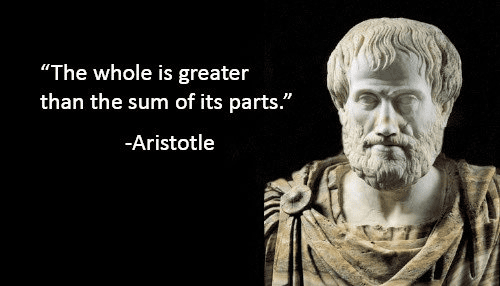
The same thing happens in the world of User Acquisition. The duo of ASO and Paid UA is much stronger together than each of them alone. And, as in the partners in crime we mentioned before, one can learn from the other – and improve with it.
First of all, Acquisition in Isolation is Insufficient
If you have a fruit shop and manage to attract many first-time customers, that’s great. But…
- If these customers come in and buy little fruit because the product is expensive or in poor condition, it’s not good news.
- Or, if they buy but don’t come back because when they took the fruit home, they realized it wasn’t very good, that’s not good news either.
Well, the same thing happens with your app. If your growth strategy is based on a “let’s bring people in and see if they pay or come back later” approach, we regret to inform you that you risk having an app that looks like this:
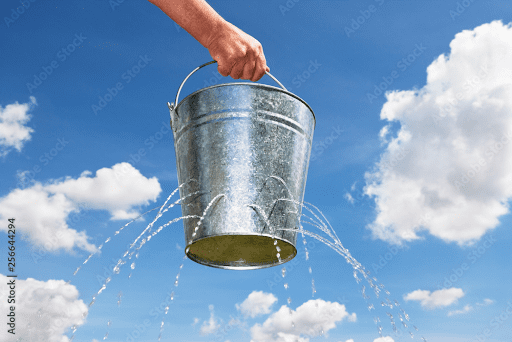
So, before we dive into this topic, we want to remind you (because we assume you already know, right? 🙃) that if you want to grow your install base, you need to consider three things:
- Your Onboarding/Activation process needs to be as optimized as possible. Here we tell you more about this topic
- Your re-targeting campaigns and CRM need to be a massive Retention weapon. If you still don’t know how to get started with your CRM, here we tell you what you need to consider when implementing one.
- Your Monetization needs to show green shoots. You’ll always want more, but if you can’t get people to pay for your product, Houston, we have a problem. Here are some interesting monetization metrics for you to consider
But assuming that you already know all of this – although if you take a look at the articles before, we won’t tell anyone – let’s get to the heart of the matter Check Our User Acquisition Agency
How does Paid UA benefit from ASO?
Without getting into what App Store Optimization (ASO) is or covering the basics of Paid UA that every person dedicated to acquisition should know, there are several things that the latter can benefit from the former.
Find the right people and places
If you have an app with subscriptions or In-App Purchases (IAPs), you may think that:
- You have to go to countries with higher per capita income
- Ideally, on iOS, which tends to pay more
Right? Well, it’s not that easy when you realize that:
- Paid UA campaigns on iOS, except for Apple Search Ads, have major tracking problems. And it’s not so fun to invest in iOS when the visibility you can have makes your ROAS noticeably decrease.
- Going after countries with higher economic capacity may sound sensible. But don’t forget that, like you, many other advertisers think the same. And most likely, your competitors too. What does this mean? That the CPCs/CPIs of countries like the United States, UK, Switzerland, Australia, etc. – generally grouped as Tier 1 – are often much more expensive. And, therefore, achieving an interesting return with campaigns may not be as easy as you had in mind.
- Many countries with high purchasing power such as Switzerland, Luxembourg, Monaco, or Singapore have a small “but” – either they don’t have a high population density – aka: you won’t catch much fish in that pond – or they have issues with English, and you’ll have to think about something that you probably didn’t want to face… creative localization!
So, if you want to go for something a little more secure, this is where ASO makes perfect sense. At the organic acquisition level, you can do a lot of testing by opening the store listing in as many languages as the App Store and Google Play allow you to. Because – fun fact – this will cost you the exact amount of 0€. Well, maybe some effort in localizing the stores with minimal keyword research. But if you don’t want to break your head over it, seek help to do this and focus on understanding the performance. And, once you have your listings defined with their metadata added (preferably in the official languages of the country), start conducting small acquisition tests. Tests that allow you to have enough volume of impressions to get an idea of the CPIs you could have. You could also talk to your representative from each ad network to understand the CPI in your industry, but this is not always easy. But don’t go crazy. Don’t put ALL localizations at once. Work in iterations and, above all, with common sense. For example, if you want to open a new region like India, you’ll find that – according to the Store – you have two languages:
- Hindi
- English
Well, maybe it would be wise to launch both, do a small proof of concept with a controlled investment in Paid UA, and see how well each listing converts. But don’t get your hopes up because:
- You won’t be able to drive traffic from your Ads to a specific listing. Whether the user ends up in one localization or another will depend more on them than on you (on their configuration, of course).
- You won’t be able to know the post-install conversion rate of each listing. Unfortunately, this is not information that the Stores share with MMPs. In fact, each “listing” has a unique ID that doesn’t change when the language changes. Do the Stores have this information? It’s possible. Will they want to share it? That’s another story…
Localization is not (just) about translation
By the way, this might be a slightly more advanced tip if you’re just starting out. But if you really want to leverage ASO to see how well localization works, repeat after me: “Localization is not just translation, Localization is not just translation, Localization is not just translation, Localization is not just translation…”. Because if I show you this picture where there is not a single word, you understand perfectly what we’re talking about, don’t you?

That’s why, when you think about localizing your store pages to test how they perform later in Paid, go beyond simply doing a quick translation of content. In fact, maybe a good strategy could be to do an AB testing where you try:
- Translating content only
- Translating + adding an element of the country’s idiosyncrasy (colors, flag, typical monuments in the screenshots, etc.)
And see how it works. Because if you want to get results for Paid UA using ASO as a “sparring partner,” the first thing you need to know is that everything you will do will be based on hypotheses that you will test, and… the data will speak! It does seem like a near-certain truth that if you intend to run campaigns targeting users in France, Spain, or China with a product page in the store in English, you are not likely to be a success story in terms of the acquisition. Or maybe you will be. If you manage to achieve wonderful results without localizing anything at all, please let us know. Tip: the best experience that people will get while interacting with you is when you localize everything from ad creatives to the app itself. Having only some of them localized might lead to confusion but it’s always a great idea to test.
Reduce your blended CAC
How many times have you heard about CAC? And LTV? Surely, if you’re reading this, quite a few times. But at the end of the day, do we only care about understanding the CAC of our Paid UA campaigns or the total acquisition cost of all our efforts? Because, ultimately, what your app needs is to acquire users who ideally come back and monetize. Going beyond your Paid UA campaigns and how much it costs to acquire each user through them, what you need to know is the total cost per user acquisition. Yes, total. This includes those who come via Paid UA, Refrral Preogram, Influencers, your website, organically, and if I may, even carrier pigeon. Let’s imagine a scenario in which:
- You have a Referral Program that pays the referrer $10 when their referred user (referee) completes the desired conversion in the app. That means the total cost is $15, because you have to pay both the referrer and the referral.
- You are investing in Paid UA across multiple Ad Networks.
- You have an influencer campaign running.

In this scenario, we can see that the total CAC (Blended CAC) is $12.59. But what would happen if we hit the jackpot in terms of metadata and start moving up from the second to the first position for a valuable keyword in the Store?
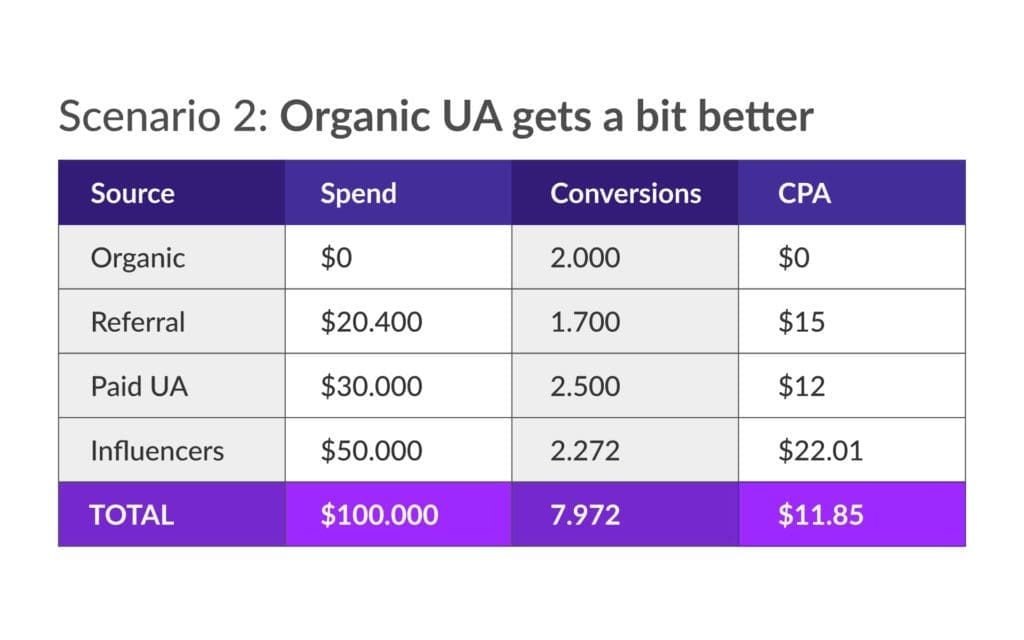
As you can see, the fact that we are performing better organically “eases” acquisition costs, even though the CAC of paid UA campaigns has not moved a cent. But this is where we can see that everything in life is not just about money. Now imagine that with this mix:
- You manage to make Influencer campaigns have an expansive effect on organic acquisition
- Your product improvements make your CAC lower in paid UA even with a stable CPI
- You even reduce your referral program’s bonus by 5% and the acquisition stays stable through that channel
As you can see, improving your organic acquisition – while keeping the rest stable – reduces your total cost. This takes some stress off the efficiency of your paid UA campaigns in the short term. But be careful! This does not mean that if you lower the Blended CAC, you can constantly increase the cost of paid UA. Because while campaigns are a great ally in many cases (lack of brand awareness, highly competitive markets, entering new geos…), they can’t be everything.

Make your upper funnel conversion rate a non-issue
With the fierce competition and growing bids, you want to decrease your CPIs as much as possible. While you can’t control how much your competition is bidding on one install what you can work on is your funnel. This is where ASO becomes even more important for Paid UA campaigns. Because ASO – unlike what you may think – is not just about organic acquisition. It’s about optimizing the Store for any user who lands on it. Therefore, this is where your ASO work has to serve your Paid UA campaigns as well. Because it’s useless to have brutal CPMs in your campaigns, with CTRs worthy of being best practices… if the conversion to download doesn’t happen when users land on the store. So it’s VERY necessary that when the user from your Ad Networks lands on the Store (whether on Google or Apple), the “house is clean”. So you need to have the conversion funnel very well worked out – depending on the store from:
- Impression to Product Page View
- Product Page View to Download
For Paid UA, the second one is especially important. So you need your ASO team/agency/specialist to understand that their work is VERY necessary not only for the Organic growth we saw in the previous table. But also for any channel downloads. To put it this way, the ASO team is in charge of supervising the quality of the food in the restaurant, regardless of whether the diner wants to eat meat, fish, or a salad later. There has to be a minimum quality in each of those foods.

On top of that, the combined efforts of ASO and paid can increase the organic rankings of your app which will increase your brand awareness. Higher brand awareness in its turn can lead to lower CPIs.
Your store presence is part of a bigger narrative
Imagine you’re on the subway and as you scroll through Instagram Stories – tired of seeing all your friends on the beach while you’re going to work – you see an ad for an app offering last-minute priced tickets to events. It catches your attention. They use a very friendly tone and even make a pun about you possibly having stayed in your city instead of going to the beach due to work. And since you like it, you click! Mini win accomplished. After clicking, it takes you to the Store and suddenly you don’t understand anything. Completely different colors, a Store in a language that is not yours (remember how important it was to localize?). You don’t understand anything. Not only because of the language but because it feels like you’ve made a mistake. That app can’t be the one from the ad. Bye. Potential download lost. Making sure that your ad creatives and store listing screenshots are consistent with each other people won’t have any confusion between the steps and will have a smooth impression to install process. You might be thinking “How can I assure consistency in my creatives and app store screenshots if I’m testing different creative concepts to increase my ad’s CTRs? Should I ask my ASO team to change the screenshots every time I’m testing new creatives?” Very valid question but it’s not necessary. This is where the concept of Custom Product Pages (iOS) or Custom Store Listings (Android) comes in. With their pros and cons, they are a valuable resource to ensure that, without having to change the store screenshots every time you test new creatives in Paid UA, your app tells a similar story before and during the download. And if you want it to tell the story after the download as well, this is where we talk about a concept known as “Targeted Onboarding“.
Conclusion
It makes no sense for ASO and Paid UA to be seen as separate entities or as two teams that do not work together – under the same and combined strategy. Furthermore, another key point to take away is that Acquisition cannot be looked at in silos, understanding (and worrying) about specific channels. You have to look at it as a whole, understanding the sum of its parts and how to make each of them more efficient. And all of this without including the fact that your Acquisition has to be interconnected with the rest of the Product. And work hand in hand. Because if your app has its product parts working in vertical lanes instead of all being in the same car, the chances of a crash on the road are much higher (and catastrophic for your app).

